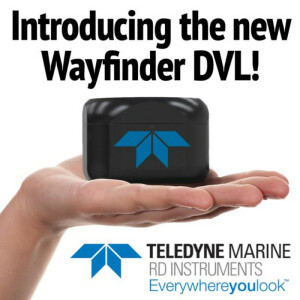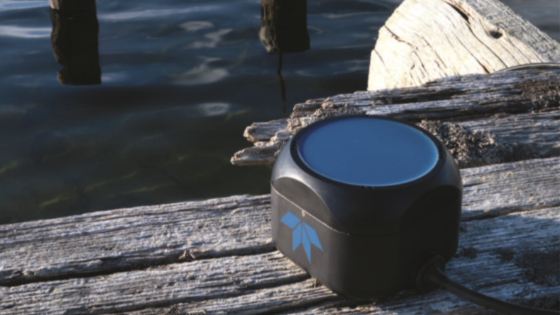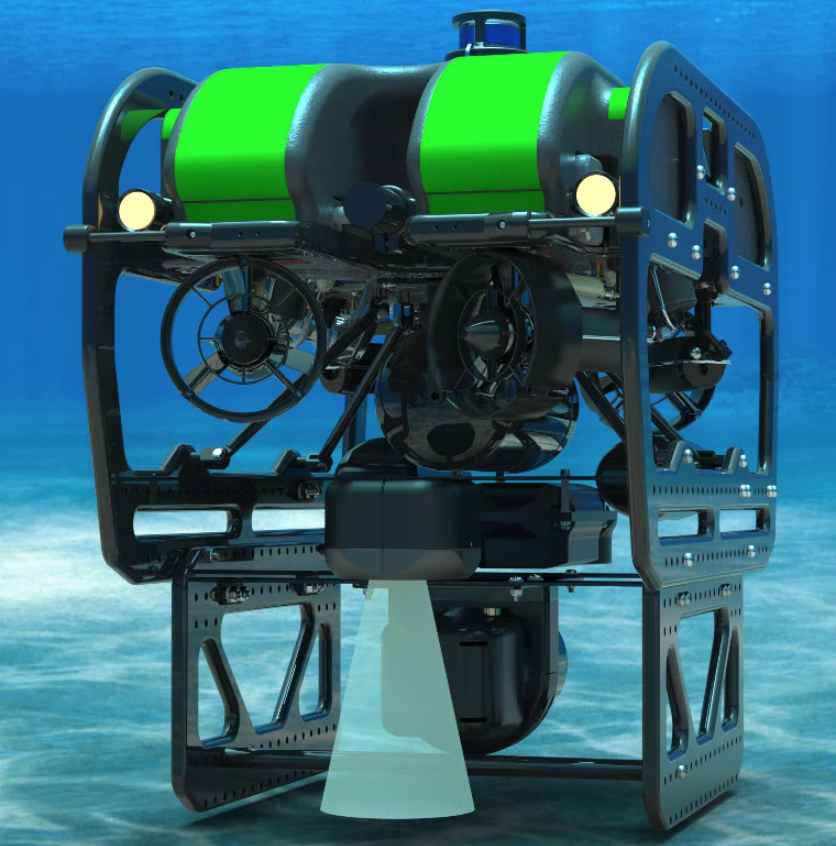

AUVs and UUVs Benefit From Worlds Smallest Phased-Array DVL
Navigation of unmanned underwater vehicles (UUVs) is a challenging task because radio frequency signals, such as GPS, only propagate short distances in water. The most recent UUV trend is miniaturisation, a large number of UUV manufacturers now offer micro-sized vehicles, enabling low-cost and rapid deployments in shallow water. Teledyne RDI has responded to this need with their new highly compact Wayfinder DVL.
What is a Doppler Velocity Log (DVL)?
A Doppler velocity log measures the relative velocity between the instrument and the bottom of a body of water by transmitting acoustic pulses in multiple beams scattered off the bottom. A common configuration consists of four beams separated in azimuth by 90 degrees and elevated from vertical by a common angle referred to as the Janus angle. The scattered sound is received, and each beam's Doppler shift is measured. For each ping, a three-dimensional velocity vector is obtained by transforming the estimated radial Doppler shifts of the acoustic beams into instrument coordinates.
How Do Unmanned Underwater Vehicles Navigate?
Navigation of unmanned underwater vehicles is a challenging task because radio frequency signals, such as GPS, only propagate short distances in water. Most UUVs require high-fidelity navigation using one of two methods: positioning through acoustic transponders or inertial navigation systems aided by a Doppler velocity log. These navigation solutions can be bulky and costly to install and maintain.
Therefore, lower-fidelity navigation solutions such as terrain or propeller-count aiding of micro-electro-mechanical systems (MEMS) INSs are sometimes utilised in cost-sensitive applications. The size and cost problems are solved by the Wayfinder DVL.
Wayfinder: The Worlds Smallest Phased-Array Doppler Velocity Log
Significant new technology advancements at Teledyne RDI, USA, have allowed fora significantly decreased DVL size while maintaining high performance and reliability.
Navigation of unmanned underwater vehicles (UUVs) is a challenging task because radio frequency signals, such as GPS, only propagate short distances in water. The most recent UUV trend is miniaturisation, a large number of UUV manufacturers now offer micro-sized vehicles, enabling low-cost and rapid deployments in shallow water. Most UUVs requiring high-fidelity navigation use one of two methods:
1. Positioning through acoustic transponders.
2. Through Inertial Navigation Systems (INS) aided by a Doppler velocity log (DVL).
Using acoustic transponders limits the operating range of the UUV to be within reach of the transponders. No such range constraint is imposed on DVL-aided navigation. However, limited payload space and cost constraints of micro-sized UUVs have historically precluded DVL-based navigation. Therefore, there is a current need to reduce the size and cost of DVLs to enable micro-sized UUVs with a high-fidelity navigation solution. Teledyne Marine, USA, has responded to this need through the new Wayfinder DVL. Teledyne RD Instruments (RDI) microsized Wayfinder DVL, the world’s smallest phased-array DVL, offers a navigation solution in a much-reduced form factor. It utilises a cost-reduced high-performance phased-array transducer and is the first instrument built from a new software-defined sonar electronics platform developed by Teledyne RDI.

Size comparison of Teledyne RD Instruments’ DVL family of products (left to right: Tasman, Pathfinder, Wayfinder)
According to R. Pinkel, professor at Scripps Institute of Oceanography, USA, the first primitive DVL was invented in 1945 at Harvard University, USA. A major step towards miniaturisation of the DVL occurred in 1995 when the phased-array DVL was invented at RD Instruments, which forms the four Janus beams from a single flat aperture. The micro-sized Wayfinder DVL is the most recent effort towards further size reduction at Teledyne RDI.
Phased-array technology and miniaturisation of the electronics platform and housing have contributed to a reduced size of over 50% compared to previous DVL generations, resulting in a 100- x 100- x 70- millimetre fully contained solution, weighing in at just 0.5 kilograms in water.
Design and Architecture of the Wayfinder Doppler Velocity Log (DVL)
All components of the Wayfinder DVL, including housing, transducer, electronics and software, are new designs incorporating four decades of Teledyne RDI experience and leveraging state-of-the-art technology and manufacturing processes. The result of the new design is a significant cost reduction while maintaining the high performance and reliability of prior DVL products. The size of the transducer is minimised by utilising phased-array technology, which forms the four Janus beams from a single flat aperture. The area of a phased-array transducer is roughly a quarter of that of a similar-performance piston transducer.
This is achieved by using a single flat phased array that forms the four Janus beams from a single aperture instead of using four individual slanted piston transducers. Cost-reduction techniques and novel manufacturing processes of the phased-array transducer has enabled the use of this high-performance transducer technology in the Wayfinder DVL, which would otherwise be cost-prohibitive.

Phased-array Wayfinder DVL installed on a micro ROV
A new electronics platform was developed and is tailored for small sizes while maintaining the performance and expanding on features of Teledyne RDI’s proven legacy platforms. This new electronics architecture is based on software-defined sonar methodology, which minimises the use of analogue components in favour of performing signal-processing functions in the digital domain. Using digital signal processing is a much more precise and compact approach than relying on analogue signal processing.
A novel oversampling technique is implemented that provides an instantaneous dynamic range of over 100dB from a 16-bit ADC with around 13 effective bits, which is 20dB more than the theoretical limit without oversampling. The advantage of this scheme is a reduced size, cost, and power. The Wayfinder DVL is optimised for size and cost, but technological and manufacturing advancements have allowed for low power consumption, a vast range of features, and highly accurate Doppler measurements. Minimum and maximum altitudes are conservatively specified at 0.5 and 60 metres, respectively. Long-term and short-term Doppler accuracy is on par with previous-generation DVLs.

Teledyne RDI’s Wayfinder is the smallest Doppler velocity log that the company has ever manufactured and the smallest phased-array DVL in the world.
Wayfinder Doppler Velocity Log (DVL) User Interface
The Wayfinder Tools software provides a graphical user interface with a Wayfinder DVL. It is a Python-based application, so it runs on various operating systems, including Windows and Linux and can be executed directly on the platform. It supports setup, diagnostics, data display and recording, and other functionality. Its design is centred around simplicity and intuitive use, allowing for all user levels.

The Wayfinder Doppler velocity log includes an intuitive software interface for ease of operation.
To facilitate vehicle integration, Teledyne RDI has developed an interface driver also in Python. This driver integrates directly with many vehicles or top-side computer systems and provides the tools to configure and extract data from the Wayfinder DVL. The concise command set and data output structure make the Wayfinder DVL very straightforward, and all the necessary data is easily accessible. In alignment with much of the small UUV community, the Wayfinder software and documentation are publicly available online for easy reference.
Applications For the Wayfinder DVL
Applications and the number of deployed UUVs, including autonomous underwater and remotely operated vehicles, have surged in the last decade. The most recent trend is miniaturisation for ease of deployment and cost purposes. A popular AUV form factor is the A-size sonobuoy, a 36-inch (91.4-centimetre) long cylinder with a 4-7/8-inch (12.4-centimetre) diameter. Micro-sized UUVs have limited payload space for sensors but greatly benefit from high-fidelity navigation solutions such as DVL-aided INS.
Some popular UUV applications include terrain mapping, pipe tracking, current measurements, target locating and water sampling. All of these applications require a robust navigation solution to reference the sensor data to the correct geographical location at which the measurement was taken. The quality of the data collected during a mission, therefore, depends on the quality of the sensor and the navigation solution. That is why DVL-aiding is desirable and important in most UUV applications. The Wayfinder DVL is designed to enable micro-sized UUVs with DVL-aided navigation at the smallest possible form factor and lowest cost.
Looking Ahead
The new software-defined sonar electronics platform supports many features that will be included in future firmware releases without requiring hardware modifications. Hence, customers purchasing a Wayfinder DVL today will later be able to upgrade the firmware in the field to enable the new features.
Wayfinder product details can be found on Teledyne Marine’s website. Full Wayfinder documentation, software, installation support and online ordering can be found on the company’s new Shopify portal.
Do you have questions about this case study?
Get in touch with Teledyne Marine, and they would be happy to answer any questions you have about pricing, suitability, availability, specs, etc.

Related products



![Do-Giant-Tortoises-Make-Good-Neighbors-1[1].jpg](https://cdn.geo-matching.com/vRMO2Edp.jpg?w=320&s=a6108b2726133ff723670b57bc54c812)




